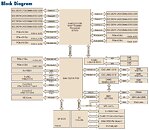Thursday, August 27th 2020

Intel Whitley Platform for Xeon "Ice Lake-SP" Processors Pictured
Here's is the first schematic of Intel's upcoming "Whitley" enterprise platform for the upcoming Xeon Scalable "Ice Lake-SP" processors, courtesy momomo_us. The platform sees the introduction of the new LGA4189 socket necessitated by Intel increasing the memory channels per socket to 8, compared to 6 of the current-gen "Cascade Lake-SP." The new platform also sees the introduction of PCI-Express gen 4.0 bus, with each socket putting out up to 64 PCI-Express gen 4.0 CPU-attached lanes. This are typically wired out as three x16 slots, two x8 slots, an x4 chipset bus, and a CPU-attached 10 GbE controller.
The processor supports up to 8 memory channels running at DDR4-3200 with ECC. The other key component of the platform is the Intel C621A PCH. The C621A talks to the "Ice Lake-SP" processor over a PCI-Express 3.0 x4 link, and appears to retain gen 3.0 fabric from the older generation C621. momomo_us also revealed that the 10 nm "Ice Lake-SP" processor could have TDP of up to 270 W.
Source:
momomo_us (Twitter)
The processor supports up to 8 memory channels running at DDR4-3200 with ECC. The other key component of the platform is the Intel C621A PCH. The C621A talks to the "Ice Lake-SP" processor over a PCI-Express 3.0 x4 link, and appears to retain gen 3.0 fabric from the older generation C621. momomo_us also revealed that the 10 nm "Ice Lake-SP" processor could have TDP of up to 270 W.

7 Comments on Intel Whitley Platform for Xeon "Ice Lake-SP" Processors Pictured
For servers and high-end workstations, the chipset is pretty much there for convenience. Anything demanding like GPUs, RAID controllers, Optane, PCIe/M2 SSDs, etc. will be connected directly through PCIe.
For example, just look at the schematics in the article, the two 10G NICs are connected directly through PCIe, which is typical for server boards, because if you needed 10G networking, why would you bottleneck the chipset by running it though there? The same is true for large RAIDs, you would hook up a RAID controller, not run it through the chipset. Having most stuff hooked up through the chipset is more a consumer thing.
I'm all for having more stable and mature chipsets. If anything I want less complexity in there and just more CPU PCIe lanes instead.More lanes is good, but at least Intel's lanes are working. There is little comfort in having 128 lanes if there are compatibility and stability issues. Let's hope Zen 3 proves to be mature enough to truly compete with Intel.
Epyc is hurting Intel right now, unfortunately. There is no need to wait for Zen 3. Intel will come back swinging though, as Enterprise is where the real profit lies.